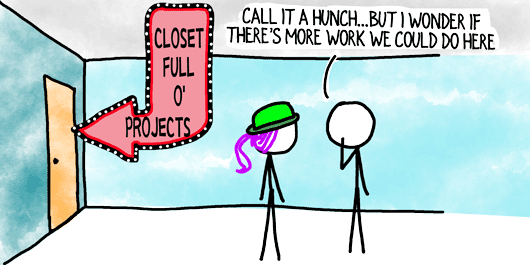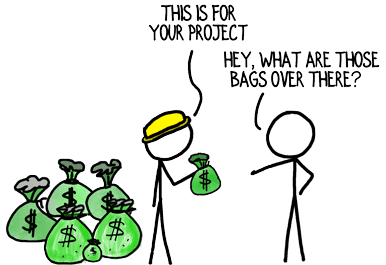Your consulting firm’s current clients are generally your best source of future projects. While it’s easy to win the follow-on projects your clients proactively request from your firm, there are even more opportunities if you and your consulting firm’s project teams learn to pick up on the telltale signs.
Let’s dive deeper.
Your consulting firm won a terrific, first engagement with Iceberg Signals, Inc., and you know that it should be easier to win another project with them than with a new client. Iceberg already Knows, Likes and Trusts your consulting firm, and that’s half the battle.*
Your decision-maker at Iceberg is Thomas (Tip) Bian, President of the Semaphore division. Tip is thrilled with your work so far, but he hasn’t given any indication he’s interested in a follow-on project with your consulting firm.
Nevertheless, it’s quite possible that Tip is giving clues about more project opportunities hidden below the surface.
Many consultants—particularly junior consultants and delivery specialists who aren’t natural business developers, have trouble spotting opportunities.
Here’s a quick guide of what to look and listen for when Tip is talking.
5 Hidden Cues a Client Has More Projects for Your Consulting Firm
Complaints
“With your help, we passed the regulatory review with flying colors. But the legal team objected. It’s like the right hand doesn’t know what the left hand is doing.”
What to Notice: Frustration, discontent, disgruntlement and disappointment. All of those emotions represent a gap between current performance and where your client wants to be. Gaps are meant to be closed with the help of consultants.
Startups
“I just appointed a group to develop a ChatGPT-related offering. I’m convinced AI is the next big wave in semaphore technology.”
What to Notice: New initiatives. A client often has enthusiasm and budget for a new idea, yet little concrete direction or know-how. A perfect situation for your consulting firm!
Big Plans
“We want to double Semaphore’s presence over the next three years. And I’m working on acquiring a drum code company—the timing seems right.”
What to Notice: Money, attention and effort flowing to ventures and programs. Much like new initiatives, big plans come with big budgets, big expectations and big anxiety. That’s fertile ground for your consulting firm.
Aspirations
“I wish we could find a steady direction for the Semaphore division. Our strategy seems to shift with the wind.”
What to Notice: Unfulfilled desires. When a sentence starts with “I wish” the speaker is saying they want something but can’t get it themselves. Your consulting firm, however, could advance them toward their dreams.
Parallels
“Semaphore accounts for 30% of the volume, and 35% of Iceberg’s profit, but our sales are flagging. The Heliograph division is larger, their work is flashier and it’s reflected in the divisional budgets.”
What to Notice: Any other potential buying locations at the client. A client that has multiple divisions, departments, line areas, geographies, functions, groups, individuals or even situations (such as events), is a prime target for expansion. If your consulting firm was engaged by one buying location and your client has others, then opportunities abound.
Your Actions:
- The first four cues from Tip can all be addressed the same way you’d treat a new opportunity surfacing during a social call: with The Turn. The magic seven words are, “Are you open to a separate conversation?”
- When you notice parallels, ask for an introduction to the decision-makers in the other buying locations. Alternatively, meet your client’s peers by incorporating them into your current engagement during the assessment phase.
- If you’re training others in your firm to win follow-on business, instruct them to alert you every time they notice one of the five cues. Reward them for observing potential lanes to expand your engagement, and teach them to discern high-potential opportunities.
Are there other phrases, situations or signals that alert you to follow-on opportunities for your consulting firm?
Text and images are © 2024 David A. Fields, all rights reserved.

 David A. Fields Consulting Group
David A. Fields Consulting Group 




Great tips to help me cue into unsaid messages. I’ve also used a variation on The Turn by asking the client, “what would you like to see happen” and/or “what do you think could help make this change/happen/etc.”. Then we have a discussion and I say “we” more to build on the partnership and try to help them see us working together going forward.
Excellent suggestion, Bill. It’s always a good idea to use inclusive language and to communicate that you’re in a partnership with your client to help them succeed.
As an aside, and only to ensure newer readers don’t get confused by terminology: asking, “What would you like to see happen” isn’t a variation on The Turn. The Turn always contains two elements: agency (“are you open…”) and separation (“to a separate conversation…”). It’s a way to change context. If you’re working on a project with a client, then you need to change the context to one in which they’re open to being sold the next project. Otherwise, they could be frustrated that you’re selling instead of just working on the engagement they hired you for.
Bill, your addition to this article and others are gold.
Thanks for the clarification, David, creating that new context is vital and how you described above highlights how vital it is. Many thanks!